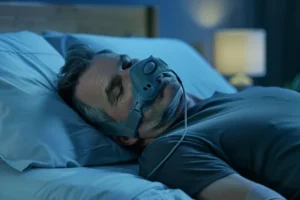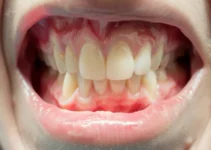Sleep apnea, a condition characterized by repeated interruptions in breathing during sleep, has been linked to various health complications, among them high blood pressure. When breathing pauses, oxygen levels in the blood drop, which can cause an increase in blood pressure as the body tries to compensate for the lack of oxygen. Over time, this persistent strain can lead to chronic hypertension, highlighting a crucial connection between obstructed sleep and cardiovascular health. Understanding this relationship is key for individuals experiencing signs of sleep apnea to seek appropriate medical evaluation and intervention.
Understanding Sleep Apnea
Sleep apnea is a serious sleep disorder that affects millions of people worldwide. It occurs when an individual’s breathing is repeatedly interrupted during sleep, leading to poor sleep quality and various health problems. Understanding the condition, its types, and its symptoms can help in early diagnosis and effective treatment.
People with sleep apnea often experience fatigue and daytime drowsiness, which can significantly impact their daily lives. Untreated, sleep apnea can lead to severe complications such as cardiovascular disease, diabetes, and cognitive impairments. This article aims to shed light on what sleep apnea is, the different types, and how to recognize its symptoms.
What is Sleep Apnea?
Sleep apnea is characterized by pauses in breathing or periods of shallow breathing during sleep. These interruptions can last from a few seconds to minutes and may occur 30 times or more within an hour. The pauses can cause a sudden drop in blood oxygen levels, prompting the brain to wake the individual to resume breathing.
Each interruption can lead to a momentary awakening that disrupts the sleep cycle. The person experiencing sleep apnea may be unaware of these awakenings, but they result in fragmented, non-restorative sleep. As a result, people with sleep apnea often feel tired and unrefreshed despite spending an adequate amount of time in bed.
There are various factors that can contribute to sleep apnea, including anatomical features like a narrow throat, lifestyle choices such as smoking and alcohol consumption, and underlying health conditions like obesity and hypothyroidism. Addressing these contributing factors is crucial for managing the condition effectively.
Types of Sleep Apnea
Sleep apnea is broadly classified into three types: Obstructive Sleep Apnea (OSA), Central Sleep Apnea (CSA), and Complex Sleep Apnea Syndrome (CompSAS). Each type has distinct causes and requires different treatment approaches.
- Obstructive Sleep Apnea (OSA): The most common type, OSA occurs when the muscles at the back of the throat excessively relax, causing a blockage in the airway. This type is often linked to excess weight, large tonsils, or a family history of OSA.
- Central Sleep Apnea (CSA): Less common than OSA, CSA happens when the brain fails to transmit the proper signals to the muscles that control breathing. Conditions such as heart failure, stroke, or the use of specific medications can contribute to CSA.
- Complex Sleep Apnea Syndrome (CompSAS): Also known as treatment-emergent central sleep apnea, CompSAS is a combination of OSA and CSA. It can occur in individuals who have predominantly obstructive sleep events but also experience central apneas.
Understanding the type of sleep apnea one has is essential for determining the most effective treatment plan. Consulting a healthcare professional who specializes in sleep disorders can provide a more accurate diagnosis and tailored treatment.
Symptoms and Diagnosis
The symptoms of sleep apnea can vary depending on the type and severity of the condition. Common symptoms include loud snoring, episodes of stopped breathing observed by another person, and gasping for air during sleep. Other symptoms may include morning headaches, dry mouth, irritability, and difficulty concentrating.
Daytime symptoms are often overlooked, but they play a crucial role in identifying sleep apnea. These include excessive daytime sleepiness, falling asleep during quiet activities like reading or watching TV, and feeling exhausted despite getting a full night’s sleep. Individuals may also experience mood swings and a decrease in productivity.
Diagnosing sleep apnea usually involves a sleep study known as polysomnography. This comprehensive test monitors various body functions during sleep, including brain activity, eye movements, heart rate, breathing patterns, oxygen levels, and muscle activity. A simplified version, known as a home sleep apnea test, may be used in certain cases.
Early diagnosis and treatment of sleep apnea are vital for preventing serious health complications. If you suspect you or a loved one may have sleep apnea, consult a healthcare provider for a proper evaluation and treatment recommendations.
To learn more about related topics and deepen your understanding of sleep disorders and treatments, be sure to check out our other articles.
The Link Between Sleep Apnea and High Blood Pressure
Sleep apnea is a common yet often overlooked condition characterized by repeated interruptions in breathing during sleep. These interruptions, known as apneas, can last from a few seconds to a couple of minutes and may occur dozens of times an hour. While it is well-known that sleep apnea can lead to poor sleep quality, there’s a growing body of evidence suggesting a significant correlation between sleep apnea and high blood pressure (hypertension).
High blood pressure is a leading risk factor for cardiovascular diseases, including heart attacks and strokes. It’s important to understand how sleep apnea can exacerbate hypertension to better manage both conditions and improve overall health. Studies have shown that people with untreated sleep apnea are more likely to develop high blood pressure, and those already suffering from hypertension may experience worsening symptoms.
Understanding the connection between sleep apnea and high blood pressure can help in the early diagnosis and treatment of these conditions. By addressing sleep apnea, not only can the quality of sleep improve, but it can also lead to better management of blood pressure, thereby reducing the risk of serious health complications.
How Sleep Apnea Affects Blood Pressure
When a person with sleep apnea experiences a breathing interruption, their body goes into a state of fight or flight response. This response is marked by a surge in adrenaline and other stress hormones, which can cause the heart rate to accelerate and blood vessels to constrict. As a result, blood pressure spikes temporarily. If these apneas occur frequently throughout the night, this intermittent elevation in blood pressure can become chronic over time.
Moreover, the repeated arousals from sleep lead to fragmented and poor-quality sleep. Sleep fragmentation can cause an increase in sympathetic nervous system activity, which is another contributor to high blood pressure. The elevated sympathetic activity promotes the release of hormones like norepinephrine that persistently raise blood pressure. Oxygen levels in the blood also drop during apnea events, a condition known as hypoxemia. Hypoxemia can stimulate the body’s stress response, which further exacerbates blood pressure increases. Chronic hypoxemia can lead to inflammation and oxidative stress, both of which have been linked to the development and progression of hypertension.
The cyclical nature of apnea-induced blood pressure spikes means that the cardiovascular system is under continuous stress, even during sleep. This constant stress can lead to the hardening of arterial walls, also known as arteriosclerosis, making it harder for blood to flow efficiently and further increasing blood pressure.
For readers interested in understanding more about health conditions and their interrelations, we encourage you to explore our other articles for a deeper dive into various health topics.
Managing Sleep Apnea to Control Blood Pressure
Sleep apnea is a common yet often undiagnosed condition that can have a significant impact on cardiovascular health. People with sleep apnea experience frequent interruptions in their breathing during sleep, which can lead to increased blood pressure and other heart-related issues. Understanding how to manage sleep apnea can play a crucial role in controlling blood pressure and improving overall health.
Research has shown a strong link between sleep apnea and hypertension. The repeated episodes of stopped breathing cause a drop in oxygen levels, prompting the brain to trigger a stress response. This response releases hormones that increase blood pressure. Over time, this can lead to chronic hypertension. Proper management of sleep apnea can help mitigate these risks and promote better heart health.
Managing sleep apnea involves a combination of medical treatments and lifestyle changes. By addressing this condition, individuals can not only improve their quality of sleep but also reduce the risk of long-term cardiovascular complications. The first step is to understand the various treatment options available.
Treatment Options for Sleep Apnea
Continuous Positive Airway Pressure (CPAP) therapy is one of the most effective treatments for sleep apnea. It involves wearing a mask over the nose and/or mouth while sleeping. The CPAP machine delivers a continuous stream of air that keeps the airways open, preventing episodes of stopped breathing.
For individuals who cannot tolerate CPAP, other options include oral appliances that reposition the jaw to keep the airway open. These devices are custom-fitted by a dentist specializing in sleep apnea treatment. They can be an excellent alternative for those who find CPAP uncomfortable.
In some cases, surgery may be recommended. Surgical options can include procedures to remove excess tissue from the throat or to reposition the jaw. While surgery is generally considered a last resort, it can be highly effective for certain patients.
Medications are typically not the primary treatment for sleep apnea but can be prescribed to address related conditions. For example, medication to reduce nasal congestion can improve airflow, and certain drugs may help manage the daytime sleepiness associated with sleep apnea.
Lifestyle Changes
In addition to medical treatments, lifestyle changes can significantly improve sleep apnea symptoms and help control blood pressure. Weight loss is particularly effective; losing even a small amount of weight can reduce the severity of sleep apnea. This is because excess weight, especially around the neck, can contribute to airway obstruction.
Avoiding alcohol and sedatives before bedtime is also crucial. These substances can relax the muscles in the throat, making it easier for the airway to become blocked. Smoking cessation is another important step, as smoking can increase inflammation and fluid retention in the upper airway.
Establishing a regular sleep schedule and ensuring an adequate amount of sleep each night can also help. Poor sleep patterns can worsen sleep apnea and elevate blood pressure. Practicing good sleep hygiene, such as keeping the bedroom cool and dark and avoiding screens before bedtime, can promote better rest. Incorporating physical activity into your daily routine can offer multiple health benefits. Exercise not only helps with weight loss but also strengthens the cardiovascular system, thereby helping to control blood pressure.
When to Seek Medical Advice
If you suspect you have sleep apnea, it is essential to seek medical advice promptly. Common symptoms include loud snoring, gasping for air during sleep, and excessive daytime sleepiness. Ignoring these symptoms can lead to increased blood pressure and other serious health complications.
A healthcare provider may recommend a sleep study to diagnose sleep apnea. This study can be conducted at a sleep center or sometimes at home and involves monitoring various physiological functions during sleep, such as breathing patterns, oxygen levels, and heart rate.
If you are already diagnosed with sleep apnea and notice a worsening of symptoms or if you experience new health issues, it’s important to consult your healthcare provider. Adjusting your treatment plan may be necessary to maintain effective management of your condition.
Early intervention can prevent the long-term consequences of untreated sleep apnea, such as chronic hypertension and cardiovascular disease. Being proactive about your health can lead to better outcomes and an improved quality of life.
By understanding how to manage sleep apnea effectively, you can take control of your blood pressure and improve your overall well-being. For more insights on related health topics, explore our other articles that delve deeper into cardiovascular health, sleep disorders, and lifestyle modifications.
Common Questions About Sleep Apnea and High Blood Pressure
Many people may not realize the link between sleep apnea and high blood pressure. Below are some commonly asked questions that delve into how these two conditions might be connected.
How does sleep apnea lead to high blood pressure?
When someone has sleep apnea, their breathing repeatedly stops and starts during sleep. This irregular breathing can cause oxygen levels to drop, which then triggers the body’s fight or flight response. This response, mainly driven by the release of adrenaline, increases heart rate and can thereafter lead to a higher blood pressure. If this cycle continues nightly, chronic high blood pressure can develop.
Can treating sleep apnea improve high blood pressure?
Yes, effectively treating sleep apnea can often lead to improvements in high blood pressure. Treatment methods like Continuous Positive Airway Pressure (CPAP) therapy help keep the airways open during sleep, ensuring steady and normal breathing patterns which help reduce blood pressure levels. Many patients see a significant reduction in their blood pressure after starting CPAP therapy, especially if their sleep apnea symptoms were severe.

My name is Salman Kapa, a 73-year-old expert in bone regeneration and dental implantology. With decades of experience in the field, I am dedicated to advancing our understanding of oral health and hygiene. Through my research and writing, I aim to contribute to the development of innovative solutions in dental care.




